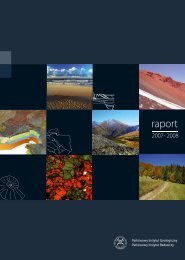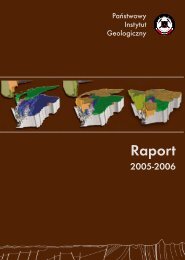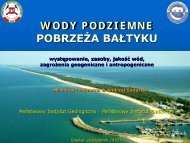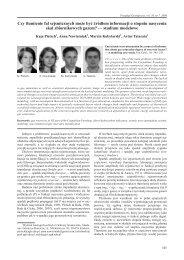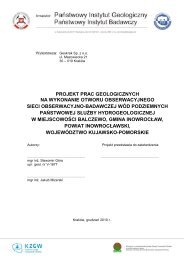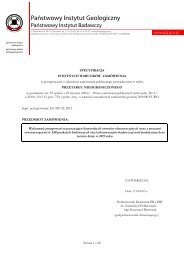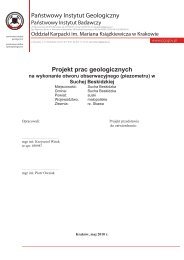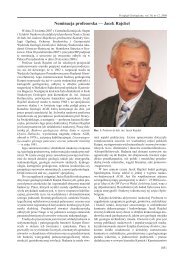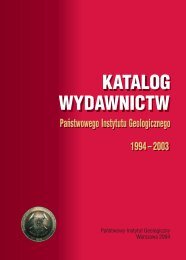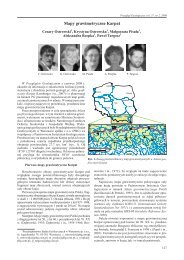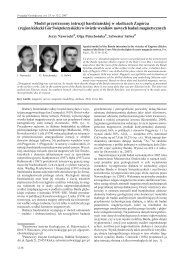Strike-slip tectonics within the SW Baltic Sea and its relationship to ...
Strike-slip tectonics within the SW Baltic Sea and its relationship to ...
Strike-slip tectonics within the SW Baltic Sea and its relationship to ...
You also want an ePaper? Increase the reach of your titles
YUMPU automatically turns print PDFs into web optimized ePapers that Google loves.
<strong>to</strong> un<strong>its</strong> 6 <strong>and</strong> 7 of Sviridov et al., 1995, respectively)<br />
exhibit prominent progradational character, with upwards<br />
convex <strong>and</strong> concave tangential seismic pattern,<br />
becoming horizontal <strong>and</strong> aggradational <strong>to</strong>wards <strong>the</strong><br />
basin centre. Dips of progradation-related reflec<strong>to</strong>rs<br />
are in <strong>the</strong> order of 10–15j. Upper boundaries of <strong>the</strong>se<br />
un<strong>its</strong> are also defined by erosional unconformity beneath<br />
<strong>the</strong> Cenozoic (Tertiary <strong>and</strong> Quaternary) series.<br />
Observed progradational pattern points <strong>to</strong> <strong>the</strong> source<br />
area located generally <strong>to</strong>wards N. It can be correlated<br />
with uplifted Bornholm Block, <strong>its</strong> erosion <strong>and</strong> deposition<br />
of syn-uplift ( = syn-inversion) sediments. Internal<br />
depositional architecture described by five distinguished<br />
depositional un<strong>its</strong> (A–E) reflects cyclic development<br />
of <strong>the</strong> Upper Cretaceous succession. Un<strong>its</strong> A<br />
<strong>and</strong> C might represent two basin-fill stages under lower<br />
energy conditions, without significant sediment progradation.<br />
Un<strong>its</strong> B, D <strong>and</strong> E formed under higher<br />
energy conditions, with more significant sediment<br />
supply <strong>and</strong> development of high-angle progradational<br />
sedimentary succession (comp. Sviridov et al., 1995).<br />
Prominent erosional unconformity between <strong>the</strong> Upper<br />
Cretaceous <strong>and</strong> Cenozoic successions indicates next<br />
stage of more regional uplift <strong>and</strong> erosion that was<br />
followed by ra<strong>the</strong>r uniform Cenozoic deposition.<br />
Wrenching <strong>within</strong> <strong>the</strong> basement might have created<br />
additional accommodation space by relative downfaulting<br />
of <strong>the</strong> <strong>SW</strong> part of this strike-<strong>slip</strong> fault system<br />
(right part of seismic profile in Fig. 7). The added<br />
accommodation space could <strong>the</strong>n be filled by rapidly<br />
prograding sedimentary bodies outbuilding from <strong>the</strong><br />
uplifted Bornholm area. Sequence boundaries <strong>and</strong><br />
o<strong>the</strong>r clearly visible key surfaces of <strong>the</strong> Upper Cretaceous<br />
succession are significantly deformed by popup<br />
structure related <strong>to</strong> strike-<strong>slip</strong> movements (Figs. 4,<br />
5<strong>and</strong>7). Topmost part of <strong>the</strong> Cretaceous succession<br />
<strong>within</strong> <strong>the</strong> S <strong>Baltic</strong> <strong>Sea</strong> is dated as Maastrichtian<br />
(comp. Poz˙aryski <strong>and</strong> Witkowski, 1990); it can <strong>the</strong>refore<br />
be inferred that part of <strong>the</strong> NW–SE wrenching<br />
<strong>within</strong> <strong>the</strong> Bornholm–Darlowo Fault Zone <strong>to</strong>ok place<br />
also ei<strong>the</strong>r during <strong>the</strong> latest Late Cretaceous, <strong>and</strong>/or in<br />
post-Cretaceous times.<br />
Development of <strong>the</strong> Upper Cretaceous sedimentary<br />
succession imaged on high-resolution seismic data<br />
could have also been influenced by <strong>the</strong> Late Cretaceous<br />
third-order eustatic sea-level changes. During<br />
Late Cretaceous times, global sea-level was high, but<br />
numerous short-term variations are reported <strong>and</strong> are<br />
P. Krzywiec et al. / Tec<strong>to</strong>nophysics 373 (2003) 93–105 101<br />
partly interpreted as a global features (Hardenbol <strong>and</strong><br />
Robaszynski, 1998). Due <strong>to</strong> lack of wells penetrating<br />
Upper Cretaceous succession of <strong>the</strong> Bornholm–Darlowo<br />
Fault Zone it was, however, not possible <strong>to</strong><br />
precisely date <strong>the</strong> sedimentary sequences observed on<br />
shallow high-resolution data <strong>and</strong> analyse <strong>the</strong>m in a<br />
context of sea-level changes.<br />
5. Discussion<br />
<strong>Strike</strong>-<strong>slip</strong> movements are often associated with<br />
inversion <strong>tec<strong>to</strong>nics</strong>, especially when compressional<br />
stresses driving <strong>the</strong> inversion are obliquely oriented<br />
<strong>to</strong> <strong>the</strong> tec<strong>to</strong>nic zones present <strong>within</strong> <strong>the</strong> sedimentary<br />
basin undergoing inversion. Within <strong>the</strong> onshore part<br />
of <strong>the</strong> Mid-Polish Trough, both NW–SE (e.g. along<br />
<strong>the</strong> Koszalin–Chojnice zone) <strong>and</strong> <strong>SW</strong>–NE (e.g.<br />
along <strong>the</strong> Grójec fault zone) strike-<strong>slip</strong> movements<br />
have been documented (Dadlez, 1994; Krzywiec,<br />
2000, 2002a). Its most north-western offshore part<br />
was inverted mostly without significant wrenching.<br />
However, as it was described in this paper, important<br />
strike-<strong>slip</strong> faulting <strong>to</strong>ok place <strong>within</strong> a wide<br />
zone located between Bornholm <strong>and</strong> <strong>the</strong> Polish<br />
coast, i.e. outside <strong>the</strong> Mid-Polish Trough proper<br />
(comp. Fig. 2). <strong>Strike</strong>-<strong>slip</strong> movements were associated<br />
also with inversion of o<strong>the</strong>r parts of <strong>the</strong><br />
Danish–Polish Mesozoic basin system. For example,<br />
inversion of <strong>the</strong> Danish Central Graben was associated<br />
with important strike-<strong>slip</strong> movements that<br />
resulted in creation of positive flower structures<br />
(Mogensen <strong>and</strong> Jensen, 1994; Vejbæk <strong>and</strong> Andersen,<br />
1987). In this area inversion <strong>tec<strong>to</strong>nics</strong> was at least<br />
partly associated with syn-tec<strong>to</strong>nic sedimentation,<br />
enhanced by uplift of basement blocks along reverse<br />
faults <strong>and</strong> <strong>the</strong>ir subsequent erosion (Cartwright,<br />
1989), similarly <strong>to</strong> <strong>the</strong> Bornholm–Darlowo Fault<br />
Zone described in this paper. During Late Cretaceous<br />
inversion of <strong>the</strong>se areas, older inherited faults<br />
were reactivated. The reactivated faults included<br />
both Caledonian <strong>and</strong> Variscan faults <strong>and</strong> faults<br />
related <strong>to</strong> <strong>the</strong> initiation <strong>and</strong> development of Permian–Mesozoic<br />
Peri-Tethyan basin system. Within <strong>the</strong><br />
Bornholm–Darlowo Fault Zone, lack of well data<br />
necessary for stratigraphic calibration of seismic data<br />
did not allow for precise dating of tec<strong>to</strong>nic movements<br />
along particular faults.





